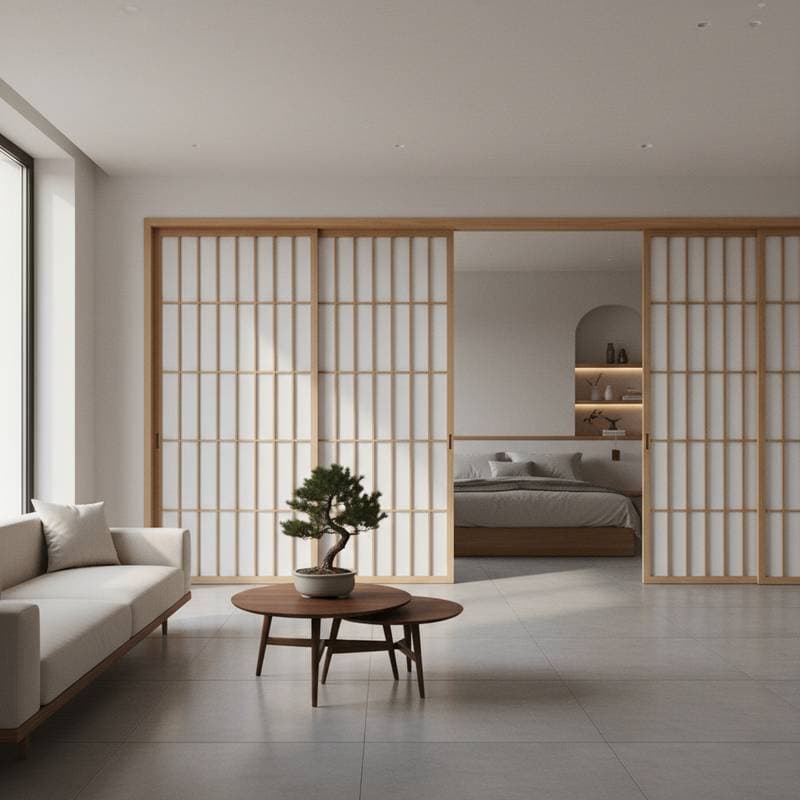The Essence of Japandi Wood-Minimalist Entryways
An entryway sets the tone for the entire home, serving as a subtle gateway to the interior narrative. Japandi design achieves this through a harmonious blend of Scandinavian practicality and Japanese poise. Natural wood forms the core, paired with precise lines and intentional sparsity, to foster tranquility right at the threshold. The focus remains on refining existing elements rather than introducing excess, resulting in a space that invites ease and reflection.
Core Principles of Japandi Design
Japandi merges the cozy authenticity of Scandinavian interiors with the disciplined elegance of Japanese traditions. Both emphasize utility, restraint, and genuine materials over ornamentation. In the entryway context, this translates to selecting only vital pieces, eliminating distractions, and letting inherent qualities like wood grain emerge naturally. Such intentionality crafts an inviting threshold that appears curated yet lived-in, promoting a sense of order from the outset.
Integrating Wood for a Welcoming Tone
Wood establishes the foundational warmth in a Japandi entryway, evoking a connection to the outdoors. Opt for light-toned varieties such as oak or ash to maintain an airy feel without overwhelming the space. Apply a matte finish that accentuates the wood's organic patterns, aligning with the style's commitment to sincerity. A front door crafted from solid oak with exposed grain anchors the design, while matching elements like a low bench or slim console extend this unity seamlessly.
Incorporate accessories thoughtfully to enhance cohesion. A bamboo organizer for mail or a wooden rack for footwear adds layers without clutter. These choices ensure the entryway supports routine tasks while upholding visual serenity.| Wood Type | Tone| Texture| Ideal Applications|
|-----------|---------------|--------------------|-------------------------------------|
| Oak| Light beige to honey | Smooth, subtle grain | Front doors, flooring, built-in benches |
| Ash| Pale, slightly cool| Fine, even grain| Wall accents, open shelving|
| Walnut| Warm brown| Bold, varied grain| Trim details, select furniture|
| Bamboo| Neutral to golden| Linear, fibrous pattern | Storage trays, hooks, mats|
Merging Minimalism with Practicality
Minimalism in Japandi entryways prioritizes utility to avoid sterility. Integrate storage solutions that blend into the architecture, such as recessed cubbies lined with the same wood as the flooring. Limit wall fixtures to sleek hooks or a single shelf, reserving surfaces for one or two purposeful items like a stone dish for essentials or a compact succulent.
This setup streamlines daily entry and exit, reducing visual chaos. Homeowners benefit from systems that conceal coats and bags, preserving the open flow essential to the style.
Optimizing Light and Neutral Palettes
Daylight plays a pivotal role in amplifying the soothing quality of a Japandi entryway. Incorporate transom windows or frosted glass inserts in the door to diffuse natural illumination, which brings out the subtle hues in wood surfaces. For evenings, select fixtures with warm LED bulbs in understated forms, such as pendant lamps with fabric shades or wall sconces in brushed metal.
Maintain a subdued color scheme to let wood elements shine. Walls in soft off-white or greige provide a neutral canvas, contrasted gently by the inherent tones of oak trim or ash paneling. This restrained palette minimizes distractions and enhances spatial depth.
Step-by-Step Guide to Implementation
-
Assess and Plan: Measure the entryway dimensions, evaluate light sources, and list required storage for items like shoes and outerwear. Determine traffic flow to position elements efficiently.
-
Prepare the Foundation: Select a unified wood species and finish for doors, floors, and accents. Strip away outdated fixtures or bold colors that clash with neutral simplicity.
-
Install Core Components: Fit the primary wood door and lay matching flooring. Add structural storage, such as a bench with integrated drawers, ensuring alignment with wall proportions.
-
Refine and Align: Verify that all wood tones harmonize under various lighting. Adjust placements to maintain breathing room around furniture and avoid overcrowding.
-
Finalize with Accents: Introduce finishing touches like a textured runner in natural fibers or a minimalist mirror. Test the space for functionality, making tweaks to support effortless use.
Sustaining Wood's Natural Beauty
Preserve the vitality of wood through consistent upkeep. Dust surfaces weekly with a soft cloth, and apply a nourishing oil quarterly to counteract dryness from foot traffic. Select finishes rated for high-wear areas, such as polyurethane on floors, to withstand daily demands.
Protect against damage by placing absorbent rugs at the entrance and using protective pads under furniture. As wood ages, its patina evolves, adding depth that aligns with Japandi's appreciation for organic progression.
Tailoring Japandi to Your Space
Adapt Japandi elements without overhauling the entire entryway. Start with a wood door replacement to introduce warmth instantly, or reorganize existing storage for immediate impact. Prioritize tonal consistency in selections, as even subtle mismatches disrupt harmony.
Consider longevity when choosing pieces; durable woods like oak endure use while gaining character. This approach ensures the design remains relevant and inviting over years.
Cultivating Daily Tranquility
Japandi wood-minimalist entryways succeed through deliberate choices in material and arrangement. Quality craftsmanship and sparse composition transform this transitional area into a restorative haven. Homeowners gain a threshold that eases the shift from external bustle to internal peace, fostering a lasting sense of equilibrium.






